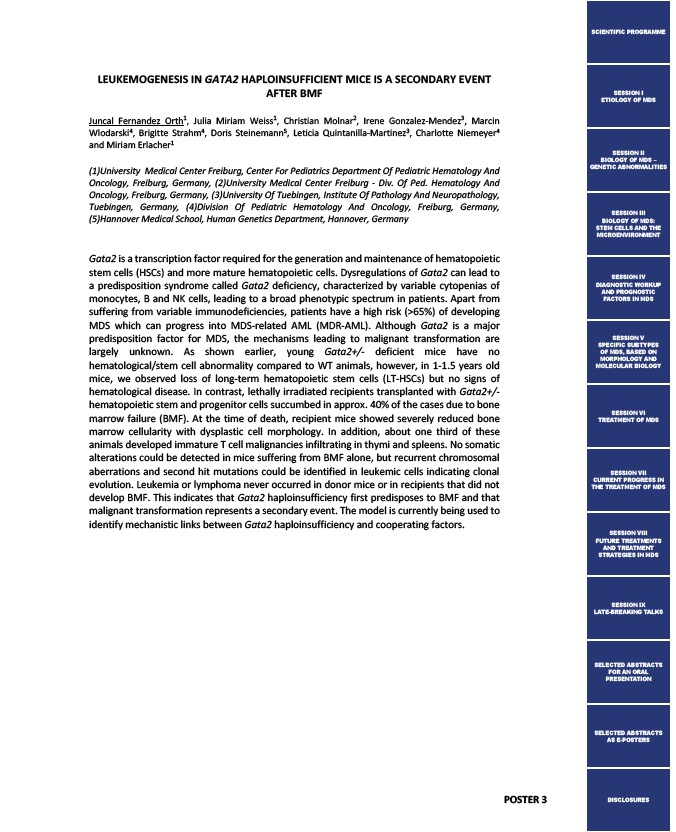
LEUKEMOGENESIS IN GATA2 HAPLOINSUFFICIENT MICE IS A SECONDARY EVENT
AFTER BMF
Juncal Fernandez Orth1, Julia Miriam Weiss1, Christian Molnar2, Irene Gonzalez-Mendez3, Marcin
Wlodarski4, Brigitte Strahm4, Doris Steinemann5, Leticia Quintanilla-Martinez3, Charlotte Niemeyer4
and Miriam Erlacher1
(1)University Medical Center Freiburg, Center For Pediatrics Department Of Pediatric Hematology And
Oncology, Freiburg, Germany, (2)University Medical Center Freiburg - Div. Of Ped. Hematology And
Oncology, Freiburg, Germany, (3)University Of Tuebingen, Institute Of Pathology And Neuropathology,
Tuebingen, Germany, (4)Division Of Pediatric Hematology And Oncology, Freiburg, Germany,
(5)Hannover Medical School, Human Genetics Department, Hannover, Germany
Gata2 is a transcription factor required for the generation and maintenance of hematopoietic
stem cells (HSCs) and more mature hematopoietic cells. Dysregulations of Gata2 can lead to
a predisposition syndrome called Gata2 deficiency, characterized by variable cytopenias of
monocytes, B and NK cells, leading to a broad phenotypic spectrum in patients. Apart from
suffering from variable immunodeficiencies, patients have a high risk (>65%) of developing
MDS which can progress into MDS-related AML (MDR-AML). Although Gata2 is a major
predisposition factor for MDS, the mechanisms leading to malignant transformation are
largely unknown. As shown earlier, young Gata2+/- deficient mice have no
hematological/stem cell abnormality compared to WT animals, however, in 1-1.5 years old
mice, we observed loss of long-term hematopoietic stem cells (LT-HSCs) but no signs of
hematological disease. In contrast, lethally irradiated recipients transplanted with Gata2+/-
hematopoietic stem and progenitor cells succumbed in approx. 40% of the cases due to bone
marrow failure (BMF). At the time of death, recipient mice showed severely reduced bone
marrow cellularity with dysplastic cell morphology. In addition, about one third of these
animals developed immature T cell malignancies infiltrating in thymi and spleens. No somatic
alterations could be detected in mice suffering from BMF alone, but recurrent chromosomal
aberrations and second hit mutations could be identified in leukemic cells indicating clonal
evolution. Leukemia or lymphoma never occurred in donor mice or in recipients that did not
develop BMF. This indicates that Gata2 haploinsufficiency first predisposes to BMF and that
malignant transformation represents a secondary event. The model is currently being used to
identify mechanistic links between Gata2 haploinsufficiency and cooperating factors.
POSTER 3
SCIENTIFIC PROGRAMME
SESSION I
ETIOLOGY OF MDS
SESSION II
BIOLOGY OF MDS –
GENETIC ABNORMALITIES
SESSION III
BIOLOGY OF MDS:
STEM CELLS AND THE
MICROENVIRONMENT
SESSION IV
DIAGNOSTIC WORKUP
AND PROGNOSTIC
FACTORS IN MDS
SESSION V
SPECIFIC SUBTYPES
OF MDS, BASED ON
MORPHOLOGY AND
MOLECULAR BIOLOGY
SESSION VI
TREATMENT OF MDS
SESSION VII
CURRENT PROGRESS IN
THE TREATMENT OF MDS
SESSION VIII
FUTURE TREATMENTS
AND TREATMENT
STRATEGIES IN MDS
SESSION IX
LATE-BREAKING TALKS
SELECTED ABSTRACTS
FOR AN ORAL
PRESENTATION
SELECTED ABSTRACTS
AS E-POSTERS
DISCLOSURES